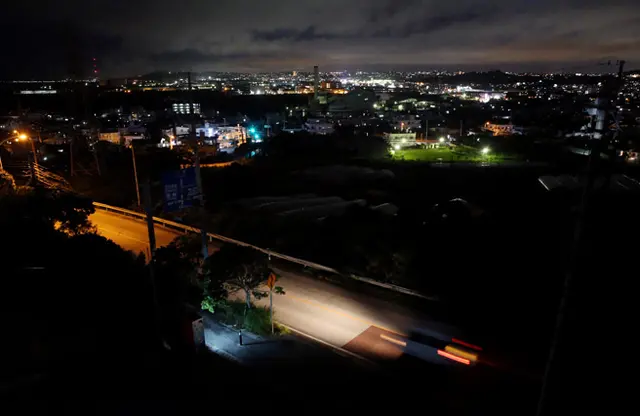Residents here were again reminded of the troubling presence of U.S. military bases when a 20-year-old local woman was found slain on May 19, the latest in more than 60 years of tragic incidents.
An American civilian worker at the nearby U.S. Kadena Air Base was arrested later the same day on suspicion of abandoning her body in a wooded area.
The atmosphere in Uruma, located in the eastern coast of the central part of the main Okinawa island, differs from that of the western coast where there are many resort hotels. Uruma is home to a large commercial complex, factories in a port, and old and new homes.
At around 8 p.m. on April 28, the young woman sent a message, “I will go for a walk,” to her roommate on her smartphone.
On a recent visit to the area in Uruma at about that time of night, few people were seen walking on a prefectural road that runs through the city. After walking for about 10 minutes, a 67-year-old man was encountered. He said that he walks for about an hour every night.
“Including young people, a considerable number of people go for walks. But we seldom see U.S. soldiers,” the man said.
In other municipalities where U.S. military bases are located, there are streets lined with bars that cater to U.S. service members and civilian workers. But there are no such streets in Uruma, although there are facilities of the U.S. Army, Navy, Air Force and Marines in the city. In addition, neighboring municipalities host Kadena Air Base.
In a 15-minute count of cars passing in front of Camp Courtney, a U.S. Marine base in Uruma, the number of general vehicles totaled 209 while that of ones related to U.S. forces totaled 53.
“Towns like here can be seen anywhere in Okinawa Prefecture. As the incident (of the 20-year-old woman) occurred in such an area, people are feeling fear,” said the man.
Uruma is an area where Eisa, an Okinawan traditional ritual, is popular. Sixty-one years ago, on the night of Eisa, another tragedy occurred.
In September 1955, Yumiko, a 6-year-old girl, was kidnapped by a U.S. soldier in the central part of the town, then called Ishikawa city (current Uruma city). The next morning, her body was found in a garbage dump on the coast about 30 minutes away by car.
The Okinawa Times reported, “Two or three pieces of grass were strongly clutched in her left hand.”
A relative of Yumiko said on May 22, “I remember (Yumiko's murder) whenever similar incidents occur. I feel pain.”
Keiko Sashida, 61, who lives near the site where Yumiko was kidnapped, said, “In Okinawa Prefecture, there are many people who suffer from anguish as victims or their family members.”
Sashida said that one of her acquaintances was sexually assaulted by a U.S. soldier and secretly delivered his baby.
“When we felt that our pain has eased, another incident occurs again. Because of that, we cannot forget those incidents even if we want to forget them,” she said.
At a branch office of the Uruma city government, black-and-white photos are displayed in a lobby on the first floor. The photographs show a destroyed school building and debris from which smoke is rising.
The explanation attached to the photos said that a U.S. military plane crashed into Miyamori Elementary School on June 30, 1959, killing 17 people, including children.
“The area around here was my house,” said Reiko Tamayama, 62, who was looking at the photographs, while pointing at one of them. “Whenever incidents or accidents related to U.S. forces take place, I remember Miyamori."
In September 1995, an elementary schoolgirl was kidnapped and sexually assaulted by three U.S. service members in Okinawa Prefecture. The incident led former teacher Hirotoshi Iha, 76, to work as a “guide for peace.”
In 1945, immediately after the U.S. forces occupied Okinawa, he saw four or five U.S. soldiers attacking a woman on a dry riverbed. In 1953, his elder brother died on a U.S. base when he was involved in a fight.
As for the latest incident involving the slain 20-year-old woman, Iha said, “In order to prevent it, I could have done more things.”
Mitsuko Tomon, 73, was serving as vice Okinawa prefectural governor when the 1995 sexual assault of the schoolgirl occurred.
“People in Okinawa Prefecture are now remembering incidents and accidents that took place in areas close to them,” she said.
In 2008 when she was serving as the mayor of Okinawa city that hosts U.S. Kadena Air Base, a junior high school student was assaulted by a U.S. Marine.
“Those incidents occur because there are U.S. bases. The only method to prevent them is to withdraw all U.S. bases (from Okinawa Prefecture),” she said.
(THE ASAHI SHIMBUN)
 简体中文
简体中文





